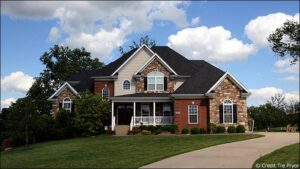The impact of technology on real estate is undeniable. It’s been essential in marketing sellers’ homes, helping buyers get more involved in the process, and increasing safety for many in the industry. Crime remains a problem in the US. In Louisville, your chance of becoming a victim of a property crime is one in 29. As a result, security technology holds great value to buyers, renters, and real estate professionals.

The Impact of Technology on Real Estate
Future homeowners, renters, and commercial property owners are demanding better security measures and real estate agencies have to meet them. To keep up with this demand, more and more real estate agencies are putting security technologies in their properties. Technology is increasing the market value of properties and changing property requirements entirely.
In this article, you’ll learn about the most crucial security technologies. Whether you work in the real estate industry here in Louisville, Kentucky, or another part of the world. Whether the property is for commercial use, renters, or buyers, these technologies are essential to please them. These security technologies consider every potential threat or intruder so that together, they protect the property as best possible.
Converged Security
Bringing both physical and cyber security teams together has been an increasingly popular security measure. Converged security allows security teams to collaborate and work together for stronger security overall. The teams will have equal knowledge of all systems and threats so they can strategize and protect properties together.
A unified security response will fill any gaps in the security detail. For example, if someone hacked the access control system to access the property physically, it is a breach of physical and cyber security.
A converged security team would be able to handle this better as they would be communicating with each other in real time and stop the attack as it’s happening. Overall, the impact of technology on real estate in the field of security has been substantial.
Hygiene-Based Technology
Since the pandemic, there has been an influx in hygiene-based technology. Many homeowners and renters are seeking hygienic security measures that not only secure their physical safety but their physical health too. Touchless access control and wellness verification technologies meet these requirements. Together, they maintain a tenant’s safety in the most hygienic way possible.
Touchless Access Control
Touchless access control goes beyond standard physical access control systems. Instead of using the usual key-locking system, touchless access control adopts touchless entry methods. They include keyless door entry systems and commercial intercom systems.
This minimizes the number of touchpoints people encounter daily, which reduces the spread of germs. Touchless access control combines hygiene and security into one easy-to-use security system where the options are endless.
Wellness Verification Technology
In the US, many people are still greatly concerned about coronavirus and the risk it poses to them. Wellness verification technology appeases that risk as it evaluates the health of every individual before they enter the building. People could take temperature readings and take digital surveys to ensure their wellness.
In commercial properties, this is incredibly useful as anyone under the weather wouldn’t be able to access the building. This reduces the spread of illness in the workplace and reassures workers that their workplace is safe.
Integrated Security Technologies
Much like converged security teams, integrating your security technologies unifies your security measures and provides better protection. Every quality property has a visitor management system, access control, and building management systems. They are essential to keep a property secure and running well.
Separately, they are effective security systems that manage various aspects of a property’s security. But together, they become stronger and work more effectively. They could set up temporary passes with access control and visitor management for regular visitors.
The visitor management system would take note of their details and set up passes to work with access control. Every time the visitor accesses the building, physical access control takes notice. This sufficiently streamlines the visitor management system while increasing the security for commercial properties and residential homes. By integrating these security technologies, they will work together to operate better.
Automated Building Management System
Every property needs efficient building management systems to create a hospitable environment for tenants. These systems manage lighting, HVAC, electrical applications, and more. By integrating these building management technologies with physical access control, automation can be triggered. This automation makes changes to building management systems based on changes in access.
This integration has numerous financial, environmental, and lifestyle benefits for tenants. If someone leaves a room, physical access control will note that and alter lighting and temperature technologies. This can reduce a tenant’s energy usage to save them money and minimize their carbon footprint.
As well, automating building management triggers has other uses. When a tenant accesses the building, access control could trigger building management systems to prepare the property for its arrival. This could include several things like turning the lights on, turning devices on, or increasing the room temperature. Automation can make life easier and more secure.


